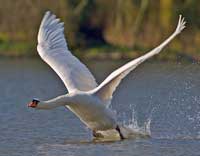 The first headlines read, “Swan Kills Kayaker,” and “Aggressive swan kills kayaker.” Later versions were more moderate – “Swan attack contributed to man’s drowning death” and “Kayaker drowns after coming too close to swan” with “Chicago Kayaker Killed After Swan Attack” falling in the middle of the spectrum. Even the BBC picked up the story – “Who, What, Why: How dangerous are swans?” writing: “A man has drowned after being attacked by a swan, which knocked him out of his kayak and stopped him swimming to shore. So how dangerous are these graceful white birds?”
The first headlines read, “Swan Kills Kayaker,” and “Aggressive swan kills kayaker.” Later versions were more moderate – “Swan attack contributed to man’s drowning death” and “Kayaker drowns after coming too close to swan” with “Chicago Kayaker Killed After Swan Attack” falling in the middle of the spectrum. Even the BBC picked up the story – “Who, What, Why: How dangerous are swans?” writing: “A man has drowned after being attacked by a swan, which knocked him out of his kayak and stopped him swimming to shore. So how dangerous are these graceful white birds?”
Anthony Hensley, 37, worked for a company in Illinois that provides swans to keep geese away from ponds and lakes in real estate developments and parks. He was tending to the swans in a pond in at a condominium development when a swan attacked. He fell from the kayak and drowned. Some reports say that the swam continued to attack him in the water. Mr. Hensely reportedly was wearing a heavy coat and work boots but no life jacket.
Coincidentally, earlier this month, a man in Aukland, NZ died when attempting to rescue his dog from an attacking swan in an Auckland lake. Are we witnessing an outbreak of killer swans? Probably not. Both these stories have two things in common. Swans and the lack of life jackets/pfds.
I know from personal experience that swans can be aggressive, are highly territorial and can be very, very threatening. Many years ago, I was rowing a dinghy in an inlet off Stamford harbor in Connecticut, when I apparently annoyed a swan some distance away. I looked over and saw a swan racing towards me, flapping its huge wings and paddling the water frantically with its webbed feet. Its head was pointed straight at me, looking like a webbed and winged guided missile. Its wingspan looked wider than my 8′ dinghy was long (and could indeed have been.)
I dropped the oars and dove into the bottom of the dinghy. A few feet away from a high speed collision, the swan put on the brakes and skid to a stop with an impressive splash, then turned sideways and paddled away as if nothing had ever happened. Why or how I bothered the bird is still a mystery to me. I was just rowing quietly and enjoying the early summer evening.
What can make swans so threatening is their size. They can reach length of over 1.5 m (60 inches) long and weigh over 15 kg (33 pounds). Their wingspans can be almost 3 m (10 ft). And they are aggressive birds. As reported by the BBC:
In April 2010, a swan on the River Cam in England made the news after repeatedly attacking rowers… Two years later, there are still calls for it to be removed from the river, as the seasonal attacks go on.
But such incidents are very rare, says John Huston of the Abbotsbury Swannery in Dorset, where there are 1,000 swans but no recorded attacks on humans in the colony’s 600-year history.
“If you approach a swan nest on the river, they might get aggressive and hiss and flap their wings, but the danger is over-rated and it’s a myth that they will break your leg or arm with their wings. They are not that strong and it’s mostly show and bluster.”
It is easy to imagine a swan either knocking or startling Anthony Hensley sufficiently so that he rolled off his kayak. But was the swan responsible for his death or was it the lack of a life jacket? Hensely’s death in cold water while wearing heavy clothes and work boots was tragic, but not entirely surprising. Between 80 and 90% of all drowning victims were not wearing life jackets.
As an aside, life jackets are now commonly referred to by the acronym, pdf, for “personal flotation device.” Apparently a lawyer working for the government pointed out that the term life jacket implied that the jack would save your life and therefore could result in liability to the government if someone should die while wearing one. Nevertheless, I have heard Coast Guard admirals refer to pdfs as life jackets. As the chances are that a pfd will indeed save your life, I see nothing soever wrong with calling them life jackets. There are no guarantees in this would but a life jacket definitively increases your odds of staying alive.
Thanks to Phil Leon for contributing to the post.

Knowing how to flip your kayak would have prevented this and/or a life jacket.